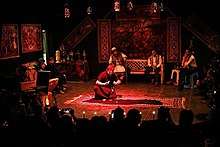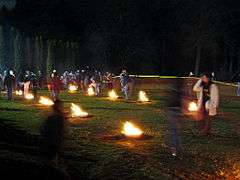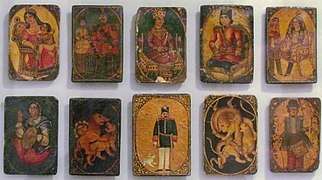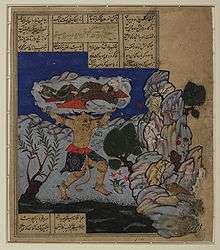Iranian folklore
Iranian folklore encompasses the folk traditions that have evolved in Iran.
| Part of a series on the |
| Culture of Iran |
|---|
.svg.png) |
|
|
Oral legends

Folktales
Storytelling has an important presence in Iranian culture.[1] In classical Iran, minstrels performed for their audiences at royal courts[1] and in public theaters.[2] A minstrel was referred to by the Parthians as gōsān in Parthian, and by the Sasanians as huniyāgar in Middle Persian.[2] Since the time of the Safavid dynasty, storytellers and poetry readers appeared at coffeehouses.[3]
The following are a number of folktales known to the people of Iran.
- Kadu Qelqelezan ("Rolling Pumpkin")[4]
- Māh-pišāni ("Moon-brow")[5][6]
- Nāranj o Toranj ("Bitter Orange and Bergamot Orange")[7]
- Sarmā ye Pirezan ("Old Woman's Cold"), a period in the month of Esfand, at the end of winter, during which an old woman's flock is not impregnated. She goes to Moses and asks for an extension of the cold winter days, so that her flock might copulate.[8]
- Šangul o Mangul ("Shangul and Mangul")[9]
- Xāle Suske ("Auntie Cockroach")[10][11]
Below are a number of historical tale books that contain Iranian folktales.
- Amir Arsalān e Nāmdār ("Amir Arsalan the Famous"), a popular legend that was narrated to Naser-ed-Din Shah.
- Dārāb-nāme ("Book of Darab"), a 12th-century book by Abu Taher Tarsusi that recounts a fiction about Alexander the Great and Darius III.[12][13]
- Eskandar-nāme, also known as "The Persian Alexander Romances", an Iranianized version of The Romance of Alexander.[14] Not to be confused with the classic book of Nezami.
- One Thousand and One Nights, the frame-story of which derives from the now lost Middle Persian work Hazār Afsān ("Thousand Nights").
- Samak-e Ayyār, a folktale about an Iranian ayyār that was written down during the 12th century.[15] Ayyār, at times synonymous with javānmard ("young man"), referred to a member of a class of warriors in Iran from the 9th to the 12th century.[16]
- Šāhnāme ("Book of Kings"), the national epic of Iran, written by 10th-century Persian poet Ferdowsi, based on Xwadāynāmag, a Middle Persian compilation of the history of Iranian kings and heroes from mythical times down to the reign of Chosroes II.[17]
- Vāmeq o Ozrā, a derivation from the Greek romance of Metiochus and Parthenope that was written down by Persian poet Onsori in the 11th century.[18][19]
Heroes
.jpg)
Heroes in Šāhnāme
- Arash the Archer (Āraš-e Kamāngir), who shot his arrow from the peak of Damavand to settle a land dispute between Iran and Turan. The festival of Tirgan is linked to this epic, besides having roots in the ancient myth of archangel Tishtrya.
- Garshasp (Garšāsp), a dragon-slaying hero in Iranian legends, now honored as jahān-pahlavān ("chief hero").[20]
- Gordafarid (Gordāfarid), praised for her daringly martial role in the tragedy of Rostam o Sohrāb ("Rostam and Sohrab").
- Rostam, a celebrated marzbān ("border-guardian"), best known for his mournful battle with his son Sohrab. He was the son of Dastan.
Other heroes
- Hossein the Kurd of Shabestar (Hoseyn Kord-e Šabestari), a Kurdish warrior from Shabestar who devoted his life to fighting for justice, representing a javānmard ("young man").[21]
- Koroghlu, a legendary hero who seeks to fight against the unjust, in the oral traditions of the Turkic-speaking peoples.
- Pourya-ye Vali, a 14th-century champion from Khwarezm, regarded as a role model by zurkhane athletes.[22]
- Yaʿqub-e Leys, under the court of whom the Persian language reemerged after two centuries of eclipse by Arabic ("Two Centuries of Silence").[23]
Characters in jokes
- Molla Nasreddin
- Dakho
Creatures
- Āl, a scrawny old woman with a clay nose and red face who attacks pregnant women when they are alone and interferes with childbirth. It is believed that she carries a basket in which she puts the liver or lung of the mother,[24] although a variety of other descriptions exist as well.[25]
- Night hag (baxtak), a ghost or an evil creature that causes sleep paralysis.[26] It is believed that the creature knows about hidden treasures, and one would be told of one of them by grabbing the creature's nose. One can rescue themself from the creature by wiggling their fingers.
- Himantopodes (davālpā), an evil creature that uses its flexible, leather-like legs as tentacles to grip and capture human beings. The captives will be enslaved and forced to carry the creature until they die of fatigue.[27]
- Demon (div; from Avestan daēva), an evil being, devil, ogre, or giant.[28]
- Ghoul (ğul), a hideous monster with a feline head, forked tongue, hairy skin, and deformed legs that resemble the limp and skinny legs of a prematurely born infant.[29]
- Genie (jenn), a supernatural creature, comparable to the elves and the goblins, that is believed to be created from smokeless fire and to be living invisibly alongside the visible world.[30]
- Manticore (mardxâr, from Middle Persian martyaxwar), a man-eater with the head of a human and the body of a lion, similar to the Egyptian sphinx.
- Amen Bird (morğ-e āmin), a mythical bird in Persian literature that flies continuously and fulfills people's wishes.[31][32]
- Pari, a type of exquisite, winged fairy-like spirit ranking between angels and evil spirits.
- The Patient Stone (sang-e sabur), the most empathetic of listeners, that is believed to absorb the sorrows and pains of the person who confides in itself.[33] It is said that when the stone can no longer contain the pain it harbors, it bursts into pieces.[33]
- Šāh-mārān ("Chief of the Snakes"), the intelligent queen of snakes who has human features above her waist and those of a serpent below.
- Simorğ (from Middle Persian Sēnmurw, Avestan mərəγō saēnō; "raptor"), a benevolent mythical bird.[34]
- Takam, the king of goats, in the folklore of the Turkic-speaking people of Azerbaijan. Traditionally, the stories of takam are recited in public theaters by a minstrel called takamchi.
- Zār, an evil spirit in the folklore of Iran's southern coastal regions who possesses individuals and harms them.
Locations
Social beliefs and practices
A stone depicting an eye that is made to protect one from an evil eye.
- Evil eye (češm-zaxm; Middle Persian: duščašm[35]), a curse believed to be cast by a malevolent glare.[36] To protect one from it, a pendant, gemstone or likewise that depicts an eye is used as an amulet.[37] Another way believed to protect one from an evil eye is to release a fragrant smoke of esfand (peganum harmala) and waft it around the head of those exposed to the gaze of strangers. As this is done, an ancient prayer is also recited.[36][38]
- Divination (morvā, šogun, fāl), including interpretation of objects which appear haphazardly, interpretation of involuntary bodily actions (sneezing, twitching, itches, etc.), observing animal behavior, playing cards or chick-peas, bibliomancy (e.g., using the poetry of Hafez Shirazi), mirrors and lenses, observation of the liver of a slain animal, the flame of a lamp, etc.[39]
- Nāz o niyāz ("coquetry and supplication"), a tradition between a lover and a beloved based on which the beloved hurts their lover by coquetry and the lover's response is supplication and insistence in love.[40][41]
- Taārof, a sort of etiquette, defined as "the active, ritualized realization of differential status in interaction".[42]
- In Iranian wedding tradition, it is customary to buy a silver mirror and two candles and place it on the wedding sofra (a piece of cloth), next to foods and other traditional items. The first thing that the bridegroom sees in the mirror should be the reflection of his wife-to-be.[43]
Ceremonies

Jumping over bonfires on the occasion of Čāršanbe Suri.
- Nowruz ("new day"), the Iranian New Year's day, celebrated on the vernal equinox.
- Traditional heralds: Amu Nowruz and Haji Firuz
- Čāršanbe Suri ("Red Wednesday"), celebrated on the eve of the last Wednesday before Nowruz[44] by performing rituals such as jumping over bonfires and lighting off firecrackers and fireworks.[45][46]
- Problem-solving nuts (ājil-e moškel-gošā)[47]
- Fālguš, an act of fortune-telling on the occasion of Čāršanbe Suri.[39]
- Sizdebedar, celebrated 13 days after Nowruz (Farvardin 13, usually coincided with April 1 or 2) by picnicking.[48]
- Mir-e Nowruzi ("prince of Nowruz") or Padešāh-e Nowruz ("king of Nowruz"), a festival that used to be held six days after Nowruz for a period of one to five days, during which a temporary commoner was elected to rule over the country.[49]
- Yaldā,[50] marking "the longest night of the year" and commemorating the birth of the ancient goddess Mithra on the eve of the winter solstice (čelle-ye zemestān; usually falling on December 20 or 21).[51][52][53]
Folk-games
- Alak-dolak ("peg [and] bat"), identical to tip-cat.[54]
- Amu zanjirbāf ("uncle chain-maker")[55][56]
- Atal matal tutule, a counting-out game, used as a children's nursery rhyme.[57]
- Āftāb-mahtāb ("sunshine-moonlight")[56]
- Ās-nās, a card game that is identical to poker.[58][59]
- Tag (bālā-bolandi, gorgam-be-havā)[60][56]
- Ganjafe, a trick-taking card game.[59]
- Court piece (hokm), a trick-taking card game that is identical to whist.
- Hopscotch (ley-ley)
- Backgammon (nard), a two-player board game.[61]
- Pāsur, a fishing card game.
- Knucklebones (qāp-bazi)[56]
- Hide-and-seek (qāyem-mušak)[56]
- Šelem, a trick-taking card game that is identical to rook.
- Xar-polis ("donkey-cop"), identical to leapfrog.
- Ye-qol-do-qol[56]
 Ās-nās cards. Brooklyn Museum, New York City.
Ās-nās cards. Brooklyn Museum, New York City. Ganjafe cards. Moghadam Museum, Tehran.
Ganjafe cards. Moghadam Museum, Tehran.- Backgammon (nard) dice and beads.
gollark: ~play why rust is better than c
gollark: LyricLy, you sound like a person who sounds like someone.
gollark: ~play bring me the horizon obey
gollark: Oh wait.
gollark: Unmute me now, apiform.
See also
- Iranian folk music
- Persian dance
- Persian theatre
References
- "DĀSTĀN-SARĀʾĪ". Encyclopædia Iranica. VII. November 18, 2011. pp. 102–103.
- "GŌSĀN". Encyclopædia Iranica. Xi. February 17, 2012. pp. 167–170.
- "COFFEEHOUSE". Encyclopædia Iranica. VI. October 26, 2011. pp. 1–4.
- McDonald, Margaret Read (1994). "The Old Woman in a Pumpkin Shell". Celebrate the World. New York: H.W. Wilson. pp. 61–70.
- Zipes, J. (2016). The Brothers Grimm: From Enchanted Forests to the Modern World 2e. Springer. p. 190.
- Heidari, Morteza (2017). "Explanation and Analysis of Mythical Themes in the Structure of the Tale of "MahPishani"". University of Isfahan. doi:10.22108/LIAR.2017.21405.
- "FICTION" [ii(d). THE POST-REVOLUTIONARY SHORT STORY]. Encyclopædia Iranica. IX. January 26, 2012. pp. 597–599.
- Omidsalar, Mahmoud. "ČELLA In Persian Folklore". Encyclopædia Iranica. Retrieved December 21, 2011.
- "HEDAYAT, SADEQ" [iii. Hedayat and Folklore Studies]. Encyclopædia Iranica. XII. pp. 121–135. Retrieved October 1, 2017.
- "New films to hit Iranian silver screens". Mehr News Agency. December 18, 2010.
(...) the story of Auntie Cockroach, as narrated by grandmas and published in storybooks over the years (...)
- Bashi, Golbarg (October 28, 2014). "The best children's books on Iran". The Guardian.
- van Zutphen, Marjolijn (2014). Farāmarz, the Sistāni Hero: Texts and Traditions of the Farāmarznāme and the Persian Epic Cycle. BRILL. p. 70.
- HANAWAY, WILLIAM L. "ĀBĀN DOKHT". Encyclopædia Iranica. Retrieved 2009-01-25.
- HANAWAY, WILLIAM L. "ESKANDAR-NĀMA". Encyclopædia Iranica. Retrieved 2009-01-25.
- "SAMAK-E ʿAYYĀR". Encyclopædia Iranica. July 20, 2009.
- "ʿAYYĀR". Encyclopædia Iranica. III. August 18, 2011. pp. 159–163.
- Boyle, John Andrew. "Ferdowsī". Encyclopædia Britannica. Retrieved July 18, 2017.
- Davis, Richard (February 23, 2012). "Greece ix. Greek and Persian Romances". Encyclopædia Iranica.
- Hägg, Tomas; Utas, Bo (2003). The Virgin and Her Lover: Fragments of an Ancient Greek Novel and a Persian Epic Poem. Leiden: Brill Publishers.
- Encyclopædia Iranica. III. August 18, 2011. pp. 191–205 http://www.iranicaonline.org/articles/azdaha-dragon-various-kinds. Missing or empty
|title=(help) - "ḤOSAYN-E KORD-E ŠABESTARI". Encyclopædia Iranica. XII. March 23, 2012. pp. 515–516.
- "ZUR-ḴĀNA". Encyclopædia Iranica. August 15, 2006.
- "Ya'qub-i Laith Saffari". Encyclopædia Britannica Online. Retrieved 2007-07-15.
- Asatrian, Garnik (2001). "Āl Reconsidered". Iran & the Caucasus. Leiden: Brill Publishers. 5 (1): 150. doi:10.1163/157338401X00189. ISSN 1609-8498. JSTOR 4030855.
- "ĀL". Encyclopædia Iranica. I. July 29, 2011. pp. 741–742.
- "BAḴTAK". Encyclopædia Iranica. III. December 15, 1988. p. 539.
- "DAVĀL-PĀ(Y)". Encyclopædia Iranica. VII. November 18, 2011. pp. 128–129.
- Omidsalar, Mahmoud (November 28, 2011). "DĪV". Encyclopædia Iranica. VII. pp. 428–431.
- Omidsalar, Mahmoud; Omidsalar, Teresa P. (February 24, 2012). "ḠUL". Encyclopædia Iranica. XI. pp. 393–395.
- "GENIE". Encyclopædia Iranica. X. February 7, 2012. pp. 418–422.
- Karimi-Hakkak, Ahmad; Talattof, Kamran (2004). Essays On Nima Yushij: Animating Modernism In Persian Poetry. Brill Publishers. p. 128. ISBN 9004138099.
...reflexivity defines the amen bird's mythic role: the bird verbalizes the people's wish and they respond with "Amen" ("So shall it be"), thereby echoing the bird's name and making the wish come true...
- Karimi-Hakkak, Ahmad (1995). Recasting Persian Poetry: Scenarios of Poetic Modernity in Iran. The University of Utah Press. p. 268. ISBN 0874804922.
He does so initially by setting up a series of connections between the amen bird and other mythical birds known or imaginable to the poem's readers.
- Habibi, Faranguis (August 30, 2011). "SYNGUÉ SABUR: PIERRE DE PATIENCE". Encyclopædia Iranica.
- Schmidt, Hanns-Peter (July 20, 2002). "SIMORḠ". Encyclopædia Iranica.
- Kapovi, Mate; Ramat, Anna Giacalone; Ramat, Paolo (2017). The Indo-European Languages. Taylor & Francis. p. 447.
- Šakūrzāda, Omidsalar, Ebrāhīm, Mahmoud. "ČAŠM-ZAḴM". Encyclopædia Iranica. Retrieved June 30, 2009.
- Moin, M. A Persian Dictionary (in Persian) (3rd ed.). p. 4752.
- "اسفند" [Esfand] (in Persian). Great Islamic Encyclopedia. Archived from the original on December 18, 2010.
- OMIDSALAR, MAHMOUD. "DIVINATION". Encyclopædia Iranica. Retrieved 2009-04-05.
- Orsatti, Paola. "ḴOSROW O ŠIRIN". Encyclopædia Iranica. Retrieved 2011-02-13.
- de Fouchécour, Charles-Henri (1989). Nâz-o niyâz, ou l’amour et l’Orient (5/2 ed.). Luqmân. pp. 77–86.
- "TAʿĀROF". Encyclopædia Iranica (online ed.). December 5, 2017.
- Omidsalar, Mahmoud. "SOFRA". Encyclopædia Iranica. Retrieved November 15, 2006.
- Lezgee, Hoda (March 20, 2015). "The Celebration of Spring in Iran".
Nevertheless, the most important curtain-raiser to Norouz is Chaharshanbe Soori which is a fire festival held on the eve of the last Wednesday of the calendar year. This festival is full of special customs and rituals, especially jumping over fire.
- "Call for Safe Yearend Celebration". Financial Tribune. March 12, 2017.
The ancient tradition has transformed over time from a simple bonfire to the use of firecrackers...
- "Light It Up! Iranians Celebrate Festival of Fire". NBC News. March 19, 2014.
- Chanchreek, Jain; Chanchreek, K. L.; Jain, M. K. (2007). Encyclopaedia of Great Festivals. Shree Publishers & Distributors. p. 150.
- "Iranians mark Sizdah Bedar in nature". Press TV. April 1, 2016.
- Epinette, Michèle (September 15, 2014). "MIR-E NOWRUZI". Encyclopædia Iranica (online ed.).
- Rezaian, Lachin (December 20, 2015). "Yalda: Iranian celebration of winter solstice". Mehr News Agency.
- Roessing, Lesley (2012). No More "us" and "them": Classroom Lessons and Activities to Promote Peer Respect. p. 89. ISBN 9781610488129.
- Hamedy, Saba (December 20, 2013). "In ancient tradition, Iranians celebrate winter solstice". Los Angeles Times.
- Foltz, Richard (October 22, 2013). Religions of Iran: From Prehistory to the Present. Oneworld Publications. p. 29. ISBN 9781780743073.
- "ALAK-DOLAK". Encyclopædia Iranica (online ed.). July 29, 2011.
- "بازیهای بومی و محلی ایران" (PDF) (in Persian). Iranian National Commission for UNESCO. 2011. p. 42. Archived from the original (PDF) on 2016-10-20. Retrieved 2018-02-25.
- "BĀZĪ". Encyclopædia Iranica. IV. December 15, 1989. pp. 60–65.
- During, Jean; Mirabdolbaghi, Zia; Safvat, Dariush (1991). Contemporary master's lesson from Darius Safvat. 1. Mage Publishers. p. 89.
- Jacoby, Oswald; Morehead, Albert. "poker Origin and spread". Encyclopædia Britannica. Retrieved January 18, 2008.
(...) Poker is virtually indistinguishable from an older Persian game called as nas, a four-hand game played with a 20-card pack, five cards dealt to each player. This coincidence led some students of games to call poker a derivative of as nas, but this theory has been discredited. (...)
- "CARD GAMES". Encyclopædia Iranica. IV. December 15, 1990. pp. 802–803.
- دانشنامۀ فرهنگ مردم ایران (in Persian). Center for the Great Islamic Encyclopedia. 2014. p. 56.
- Schädler, Ulrich; Dunn-Vaturi, Anne-Elizabeth (2016). "BOARD GAMES in pre-Islamic Persia". Encyclopædia Iranica (online ed.).
Further reading
- Daniel, Elton L. (2006). Culture and customs of Iran. Greenwood Press. ISBN 0-313-32053-5.
- Omidsalar, Mahmud (2005). "Magic in literature and folklore in the Islamic period".
External links
| Wikimedia Commons has media related to Folklore of Iran. |
- Iran: Daily life and social customs. From the Encyclopædia Britannica.
- Folkore studies of Iran, Afghanistan and Tajikistan. From the Encyclopædia Iranica.
- Folk poetry. From the Encyclopædia Iranica.
- The passion (taʿzia) of Ḥosayn by Peter Chelkowski. From the Encyclopædia Iranica.
- Lee Lee Hozak, on Iranian folkloric songs among Iranian Americans, from Homa Sarshar's In The Back Alleys of Exile (vol. 2; p. 304).
This article is issued from Wikipedia. The text is licensed under Creative Commons - Attribution - Sharealike. Additional terms may apply for the media files.
